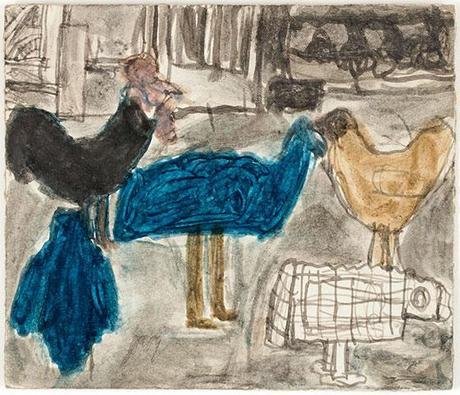The Smithsonian American Art Museum is screening James Castle: Portrait of an Artist in conjunction with our installation of James Castles' work, on view at the museum through February 1, 2015. In 2013 we acquired 54 pieces by James Castle, and we have one of the largest public collections of Castle's work. Untitled: The Art of James Castle features a representative selection of the artist's immense oeuvre, including drawings, handmade books, texts, and constructions.
The screening will take place Monday, December 1, 2014 at 6:30 p.m. in American Art's McEvoy Auditorium. And the program is free. Public programs coordinator, Katie Crooks, spoke with the film's director Jeffrey Wolf, who will be on site to field questions after the screening, to find out more about his work and his fascination with Castle.

James Castle's Untitled
Eye Level: I looked you up on IMDb, and you have an impressive number of film credits under your belt. Can you tell us a bit about your professional history —how you came to work in film?
Jeffrey Wolf: I am a born storyteller. As a young man photography, journalism, fish tales, humor, and a good imagination were always part of my résumé. My parents both immigrated here from Europe, having been chased out of their respective homes in (Austria and Germany). As you can imagine there were many harrowing tales told to me from that experience. After getting a college degree I set out for New York City and took every film job I could wrangle my way into. I found that medium most appeaing to me. I draw on these life experiences every day.
EL: How did you first learn about James Castle and decide to make A Portrait of an Artist?
JW: I first saw James Castle's work at the Outsider art fair ten years ago. I have shown an interest in self taught artists for many years. This interest started when I first came upon the artist/woodcarver Elijah Pierce. My interest expanded following the Black folk art in America show at The Corcoran Museum in 1982. This led to me wanting to make films about this art. It was only after years of gestation that I was able to form a perspective to start from. I started a foundation with towards the goal of making films and education, James Castle proved to be the first film we were able to make. I felt Castle was a great example of all the elements that I found interesting in the field. So, I was able to talk about self taught art and tell the story of James Castle at the same time.
EL: What did you learn about Castle during the film making process that was most surprising?
JW: That is a very interesting thing about his work. It is very surprising. It's like peeling an onion. There are layers and layers of depth to his work.
First you think it's childlike and then all of a sudden you're looking at an intricate coding system that somehow came out of his minds eye. There are so many stages of amazing work in between as well. There is so much of 20th century art reflected in the work as well. Another big component of this American story is the fact that his family was such an important part of it. Without the family saving his work we may never have been able to see it.
EL: What is the most important thing you'd want viewers of this film to take away?
JW: Art can be looked at in so many different ways and it has so many different labels. I want the viewer of my film to consider James Castle's output, his context, and the supreme quality of the work in evaluated his place in art history. In the end it's all about what new ideas, concepts and connections the artist has produced that enriches us.
EL: If you were able to communicate with Castle today, what one question would you ask him?
JW: I would want to know if he felt I did a good job in telling his story.

